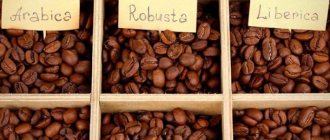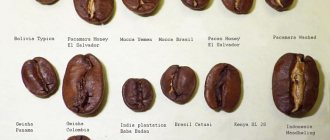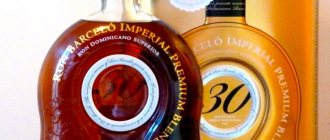July 12, 2010 Slang and terms
- Coffee
is a drink made from ground roasted coffee beans and water. Due to the caffeine content it has a stimulating effect. - Coffee
is the bean and seed of the berry of the coffee tree, which grows in a narrow subtropical zone at altitudes of up to 6,000 feet above sea level. - Coffee
is a coffee tree, an evergreen tropical plant belonging to the genus coffea of the rubiacee family.
Content
- 1 Wiktionary
- 2 Spelling dictionary
- 3 Large explanatory dictionary
- 4 Encyclopedic Dictionary
- 5 Ozhegov's Dictionary
- 6 Dahl's Dictionary
- 7 Explanatory Dictionary by Efremova
- 8 Ushakov’s Explanatory Dictionary
- 9 Types and varieties
- 10 Coffee drinks
- 11 Translation
- 12 Three faces of coffee
- 13 Coffee as medicine 13.1 Links
- 13.2 Bibliography
- 13.3 Quotes
Wiktionary
- Morphological and syntactic properties
coffee
Noun, inanimate, masculine, indeclinable (declension type 0 according to A. Zaliznyak’s classification). It is also acceptable to use it as a noun. neuter. Root: -coffee-.
- Pronunciation
MFA: units h. [?ko.f??], pl. h [?ko.f??] Pronunciation example
- Orthoepy
Outdated pronunciation: [?ko.f?]
- Meaning
- food product, coffee beans, whole or ground ? Grind coffee. ? Chocolate covered coffee. ? You can import up to 1 kg of coffee, up to 5 liters of alcoholic beverages and up to 20 packs of cigarettes duty free. “Across Borders” // “Behind the Wheel”, 2004 (quote from the National Corpus of the Russian Language, see References)
- an aromatic, invigorating, dark-colored drink, usually consumed hot, made from roasted coffee beans ? And from them two boys came out in smart clothes, and, having come to the envoy, they danced and threw themselves over their heads, then the Derbent saltan and others asked the envoy to stop near one of the gardens, which is right next to the settlements, and brought coffee and, having drunk, went to the city . “Correspondence and affairs during the embassy of Artemy Volynsky,” 1716-1718 (quote from the National Corpus of the Russian Language, see References) ? Then the father quickly finished his coffee and retired to his office. Vera Belousova, “The Second Shot”, 2000 (quote from the National Corpus of the Russian Language)
- Synonyms
- Kofiy (simple)
- Hypernyms
- product, grains
- drink, drink
- Hyponyms
- Arabica, Mocha
- Espresso, Cappuccino, Glace, Latte, Mocha, Ristretto
- Related words
- diminutive-affectionate forms: coffee pot, coffee pot, coffee pot
- other nouns: Coffee pot, Coffee maker, Coffee grinder, Coffee shop, Caffeine, Coffee
- adjectives: coffee, caffeinated
- verbs: to have coffee, to have coffee
- Etymology
From Arabic ???? (qahwa; originally meant a type of wine). In a number of European languages, the word is borrowed. through. Turkish kahve. Further origins are unknown; it is possible that qahwah came from the name of the Ethiopian region of Caffa, the birthplace of the coffee tree (in Caffa itself, coffee is called “buno” or “bunna”). Russian borrowed coffee via English coffee or Dutch koffie from tour.
Large explanatory dictionary
to about
fe, unchangeable; m. [Gol. coffie from Arabic]
- A tropical tree or shrub, with reddish berries, the pulp of which contains two seeds; a coffee tree.
- collected The seeds (grains) of this tree, from which a tonic drink is prepared. Roasted k. Do you have k. in grains?
- Powder made from roasted and ground seeds of this tree. Grind k. // A surrogate for such a powder. Instant coffee. (powder or granules that just need to be dissolved in hot water to make such a drink). // A drink prepared from such powder. K. in the East. Turkish K. Cup K. Black K. K. with chicory. Boil it. Drink it with milk.
- Drinking such a drink. Morning k. Invite to k. < Coffee (see). Coffee, coffee (-y); m. Lask. (except 1 digit). Buy a coffee. I'd like to drink some coffee. I ask you to visit Kofeyochek, -chka (-chka); m. Reduce-affection.
The meaning of the word coffee
or Coffee (Coffea L.) is a genus of plants from the madder family (see). Shrubs or small trees. The leaves are arranged in opposite pairs or in threes, leathery, perennial or herbaceous, entire, equipped with stipules. Flowers are in the corners of the leaves, sit in clusters, rarely solitary, white, bisexual, often fragrant. The number of parts in the calyx and corolla ranges from 4 to 9, but mostly 5. The corolla is fused-petaled with a short or long tube. The ovary is solid, round or almost cylindrical, 2-locular, contains 1 ovule in each ovule; the style is divided into 2 filamentous stigmas. The fruit is berry-shaped, with 2 seeds. There are 20 species that grow wild in hot countries of Africa and Asia. The most famous species is Coffea arabica L. A tree 6 to 8 meters high, with outstretched branches; the leaves are leathery, glossy, opposite, 14 centimeters long, oblong or ovate-oblong, pointed. Flowers in bunches of 3 and 7 in the corners of the leaves, white fragrant - quintuple; The oblong fruit is red, and at the end purple, oval, 14 millimeters long. The seeds are oblong, flat-convex, with their flat sides facing each other, on which a longitudinal groove is noticeable. Consist of horny endosperm (protein); embryo with ovoid cotyledons. These seeds are known to everyone under the name coffee or coffee. K. comes from East Africa, from Abyssinia. K. was transported to Arabia at the end of the 15th century, but it began to spread in Europe no earlier than the middle of the 17th century. Currently, it is bred in all tropical countries of the Old and New Worlds, where the average summer temperature is not lower than 14½ R. The first attempts to breed K. were made by the Dutch in Java in 1650 and in Suriname in 1718. In 1722, K. began to be bred by the French in Martinique and by the British in Jamaica. The first cargo of Javanese K. arrived in Holland in 1719. K. varieties are numerous. The lower grades are supplied by Brazil, in quantities of about half of the K. produced throughout the globe. Then come Javanese (1/5 of the total production), Ceylon (1/10). Mocha is the least traded - only about 8 million pounds, while the Brazilian variety produces more than 200 million. Mocha is considered the best, but there is no real mocha in the trade at all not available: this name refers to African, exported through Cairo. African varieties partly go through Mocha. Indian seeds are distinguished by large seeds, and mocha seeds are small. Among the American ones, Martinique and some Peruvian ones are considered the best. K. seeds, or as the Germans call them, coffee beans (Kaffee-Bohnen) contain a special alkaloid caffeine, close to the theine of tea and theobromine of chocolate, and caffeic tannic acid. K. the tree begins to bear fruit in the third year, but rarely lasts more than 12 years. It blooms and bears fruit throughout the year, but the main harvests occur in spring and autumn. After collection, the pulp of the fruit is separated in various ways from the seeds, which are dried, but this is not always possible due to the enormity of the collection; therefore, cleaning has to be done gradually, which often reduces the quality of the product. Another species of C., relatively recently discovered in Africa, namely in western: Sierra Leone, Monrovia, Angola, is C. lieberica Hiern. It is distinguished by its large leaves, twice as large as the leaves of the common K., and larger flowers, the corolla of which consists of 6 and even 9 petals. The fruits are much larger. The yield of Liberian K. is greater than usual. Currently, products of this new variety are already commercially available. The culture of ordinary K. in rooms on windows and in greenhouses works very well. It requires nutritious turf soil and moderate watering; with good care it bears fruit. See Coffee (hygienic).
A. Beketov.
Coffee (hygienic). — By the name coffee we mean the beans of the coffee tree freed from the pulp, from the outer, and partly also from the inner seed coat (see Coffee; botanist). Its homeland is considered to be southern Abyssinia, mainly the lands of Caffa and Galla, from where in the 15th century. the tree was transplanted to Arabia and Constantinople. K., which began to spread throughout Europe in the mid-17th century, was exported almost exclusively from the port city of Mocha in Arabia, selling at a fabulous price - 300 francs per kilogram. Currently, coffee plantations are grown throughout the tropical and subtropical zone. Each hectare of coffee plantation contains about 900 trees, each of which produces from 2.5 to 12.5 pounds of coffee seeds throughout the year. The coffee fruit, which in appearance and color resembles a small cherry, contains two coffee beans adjacent to each other with their flat sides, surrounded by tender seed (inner) and parchment-like (outer) seed coats and fruit pulp. To clean coffee beans from pulp and shells, different plantations use different methods, depending mainly on whether they sell completely ripe beans (the best varieties) or whether they also use not quite ripe ones. In the first case, the berries that fell when the tree was shaken are dried for some time in the sun, after which it is easy to crush them and remove them from the beans; in the second case , not quite ripe berries picked Purified K. either immediately goes on sale or is left for several years in cool, well-ventilated areas for further ripening, and its weight is significantly reduced, often by a whole third; but similar, aged K. greatly benefits in quality, acquiring a particularly strong and pleasant aroma after frying. Studies carried out on the comparative weight of both poor varieties of K. (Haiti, Guadeloupe, etc.) and those with good aroma, smell and taste of expensive varieties (Mocha, Java, Ceylon) proved very noticeable gravimetric differences between them: for example, 1 deciliter Ceylon beans weigh 508 g, Java - 450, Mocha - 5*0 g, Rio de Janeiro - 522, Haiti - 642, Venezuela - 654, Guadeloupe - 660 g. Depending on the place of origin, there are many varieties of beans, somewhat different from each other, in addition to the special specific smell and taste they develop during frying, also in the color of the beans, their shape, their different length, width and thickness, and the greater or lesser concavity of the front side beans, different concavity of the grooves located on their front surface, etc. The best variety is considered to be the Arabian K. "mocha", with very small (8-11 mm in length, 7-8 mm in width and 3-4 mm in thickness) ovoid, dark yellow , with green beans that have a very pleasant aroma. consumption in various European countries is expressed in the following figures (per year per person): in the Netherlands - 7.14 kilograms, in Belgium - 4.24, in Norway - 3.45, in Switzerland - 3.01, in Denmark - 2.45, in Germany - 2.38, in Sweden - 2.39, in France - 1.43, in Austria-Hungary - 0.84, in Italy - 0.47, in England - 0.45, in Russia - 0.1 kg (1/4 lb). Possessing a strong, astringent taste and extremely difficult to turn into powder, raw coffee beans are not consumed directly to prepare a decoction, but are first subjected to a roasting process, during which, depending on its degree, more or less profound physical and chemical changes occur in the coffee beans. Taking on, depending on the temperature and duration of its action, a reddish-brown or dark brown color, K., due to the expansion of its tissues, due to the expansion of gases formed during frying, significantly increases in volume (by 1/3 and even 1/2 ), and next to this its weight decreases by approximately 17-20%. Further, along with the loss of almost the entire amount of water and sugar and the destruction of a significant part of the fiber, in coffee beans, when they are fried, special burnt substances and frying products are formed (palmitic, acetic and carbonic acids, caeol, hydroquinone, methylamine, pyrrole, etc. .), of which coffee oil - kafeol, is mainly attributed to the specific taste and aroma inherent in burnt coffee, and some are also attributed to the increase in the strength and frequency of heart contractions caused by coffee.
The composition of raw and fried K. is expressed, according to Koenig, in the following figures: composition of raw K.: water - 11.2% or more (in dry matter), fat - 14.9%, proteins - 13.8%, sugar - 3.66%, fiber - 31.24%, caffeine - 1.34%, ash - 3.92%, hot water soluble substances - 30.93%; composition of fried K.: water - 3.19% or more (in dry matter), fat - 16.14%, proteins - 14.28%, sugar [Other researchers found even less sugar in K. (0.17% - 0.47%). The low sugar content in fried K. serves, as we will see below, a very characteristic feature that distinguishes K. from the very sugar-rich surrogates, chicory and wine berries that are most often added to it for the purpose of adulteration.] - 1.35%, fiber - 25.07, caffeine - 1.42%, ash - 3.87%, soluble substances - 30.6. As can be seen from the data given, K. gives about 30% of the substances to the hot solution; with the method of preparing coffee decoction used in the hostel, about 25% of the extractive substances are transferred into the latter; according to Koenig's analyses, in a K. cup prepared from 10 g. substances, 0.5 g is transferred. fat, 0.4 g. minerals and 0.5 g. nitrogen (from caffeine), therefore, K. should be viewed only as a flavoring substance that excites the central nervous system, and not as a food substance, as Payen, Liebig and Rohleder erroneously propagated in their time. From the experiments of Voith, Py and Gerlein, it is clear that K. does not slow down the processes of decomposition of nitrogenous substances in the body and, therefore, does not serve as a material that preserves the body’s tissues; however, when drunk, as is usually done, with milk, bread, or sugar, K. indirectly is a very good conductor of nutrients rich in nitrogen, fat and carbohydrates. Coffee’s widespread popularity is mainly due to its stimulating effect on the nervous system, due to the content of caffeine and caféol, which is why when consumed it increases the frequency and energy of heart contractions and temporarily increases working capacity, both spiritual and physical. K. differs significantly from alcohol in that the effect it stimulates is longer, and on the other hand, after the period of excitement, depression does not set in, as with alcohol consumption, which is why hygienists, not without reason, see in the widespread development of cheap coffee (and tea) shops a powerful, a good competitor in the fight against alcoholism. It should not be forgotten, however, that abuse of the drink, especially chronic, often leads to disorders in the sensory and motor areas, which is why you should refrain from using it in case of certain diseases of the nervous system (epilepsy, hysteria, etc.), as well as in cases of some heartache. It is also impossible not to warn against the use of K. in childhood. “We are firmly convinced,” say Rossbach and Nothnagel, “that premature consumption of strong K., also, of course, tea, is one of those many factors that give rise to a neuropathic disposition, and if it exists hereditarily, then contributes to its further development.” . K. is usually fried until chestnut brown (care must be taken not to overcook it); at home - in a frying pan set over hot coals, or even better, in a closed brazier; in factories - with superheated steam. To prevent aromatics from escaping, roasted beans should be kept in a tightly sealed container; It is best to grind K. just before drinking the drink, for the preparation of which the finely ground powder is doused with boiling water and infused without boiling for 5-10 minutes; with longer infusion or boiling, too much tannic acid, burnt and bitter substances pass into the solution, causing the aroma of the potion to deteriorate and weaken and its taste to deteriorate.
All kinds of dried, fried and ground substances from the plant kingdom serve as substitutes for K. (its surrogates) roots - chicory, beets, carrots, dandelion; b) substances rich in sugar - burnt molasses sugar, wine berries, Constantinople pods; c) substances rich in starch - acorns of various types of oak, rye, barley, oats, wheat, barley malt, etc.; d) seeds of leguminous plants - common peas, coffee peas (Astragalus boeticus), Chinese beans (Soja hispida), common beans, lupins or fava beans, etc., f) fat-rich substances - common walnut, as well as American, walnut, groundnut etc. Containing neither caffeine nor caféol - the two most important components of natural K. - and therefore not possessing the stimulating effect inherent in the latter on the central nervous system, K. surrogates have in common with natural K. only the ability to communicate to the prepared , after roasting them, the drinks have a certain smell, aroma and taste, at least vaguely reminiscent of K. - qualities with which an unpretentious poor person is completely satisfied in his everyday life. The widespread use of chicory and wine berries is also due to their ability, despite their cheapness and availability, to release into a hot solution a much larger amount of soluble and coloring substances (2½ times) than natural berries; The fame that acorn, barley and rye fruits enjoy among the public is explained by the special nutritional and dietary advantages attributed to them, although without any reason. From a hygienic point of view, of course, nothing can be objected to the use of various kinds of surrogates (with the exception, however, of K. from lupins, the prolonged use of which causes severe headaches), when they are sold at a cheap price and under their own name. Unfortunately, however, surrogates for K., as we will see below, are used mainly to falsify natural K., which is why acquaintance with their chemical composition, as well as, of course, with their histological structure, is interesting in itself, extremely It is important when identifying certain impurities in commercial burnt and ground K., passed off as natural. The table below shows the results of the analyzes performed by Dr. Kotsyn of both natural K. and, in comparison with it, some of the most commonly used surrogates: a sharp, as can be seen from the table, difference in the chemical composition between natural K. and the substances replacing it gives the opportunity, with the help of chemical examination (near microscopic) of a product suspected of falsification, to determine not only the nature of the impurities contained in it, but, in most cases, with greater or less accuracy, also their quantity.
Composition of natural coffee and pure surrogates.
Falsification of K. is already evident in relation to beans, both raw and fried, mainly, however, in relation to fried and ground K. sold in a completely ready-to-eat form. The more often practiced, relatively innocent, falsification in the sale of coffee beans consists in a mixture with expensive varieties of cheaper ones; further, in order to artificially increase the weight of the beans, which is beneficial for traders, the latter, during roasting, are often sprayed with Vaseline, treacle sugar or other low-value substances. In order to mask beans that are somehow spoiled and have lost their natural color and consistency, the latter are shaken with lead balls or tinted with dyes that are often harmful to health. Counterfeiters even put on sale artificial beans made from wheat, barley, bean and maize dough, from which, using special machines, they prepare grains that are carefully counterfeited to look like real ones. But more often and more variedly there is a counterfeit of burnt and ground K., in which, as we have already said, all kinds of surrogates are mixed, in fried and crushed form, differing little in appearance from the real K. From the research carried out by Dr. Kotsyn it is clear that Burnt and ground chicory sold in Moscow, often under fantastic names (“amateur chicory”, “economic”, etc.), almost always appears to be adulterated, mostly chicory and wine berries, with the admixture reaching 30-70%.
Microscopic examination gives very valuable indications in recognizing the purity of K. and the content of one or another admixture in it, which is why the histological picture of both K. and the surrogates most often mixed with it - chicory and wine berries - is given here in essential features. The parenchyma of the coffee bean consists of closely spaced, thick-walled cells without intercellular spaces, the colorless walls of which have very characteristic nodular thickenings; the shape of the cells is varied: rectangular, trapezoidal, rhombic, etc. — The seed coat covering the bean, already completely erased from the surface of the burnt bean, is well retained, however, in a groove located on the flat side of the bean, from where it penetrates deeply into the bean, covering the inner surface of the endosperm; its length is about 2 square meters. see why particles of this shell are always found in ground K.; Characteristic of it are the very long (0.2-0.7 mm), thick-walled, spindle-shaped or whetstone-like clerenchyma cells embedded in it, penetrated by wide pores. — Chicory is recognized by the milky vessels contained in the inner white bark and bordering it in the phloem , with a width of 0.006 to 0.01 mm, as well as thin-walled, bundled sieve tubes; in addition, short, moderately wide vascular cells embedded in the wood, the side walls of which are lined with transverse, mostly slit-like thickenings, stand out sharply under a microscope. — Wine berries are characterized by thin vascular bundles contained in the parenchyma of their meat and considerable width (0.05 mm, i.e. wider than that of chicory) milky vessels, with clearly visible walls; further, the upper skin contains small, polygonal thick-walled cells, in many places located in the form of a rosette around the hair pit, in which hair is sometimes preserved; As for the grains of wine berries, the seeds they contain are covered with a very hard and hard shell, in which large, rounded angular stony cells protrude, with a narrow lumen and layered walls, penetrated by numerous steam channels.
Literature, König, “Die menschlichen Nahrungs- und Genussmittel” (1893, Bd. II); J. Bell, "Die Analyse und Verfälschungen der Nahrungsmittel" (Bd. I); Dammer, “Illustriertes Lexikon der Verfä lschungen und Verunreinigungen der Nahrungs- und Genussmittel” (Lpts., 1887); "Vierteljahrschrift über die Fortschritte auf dem Gebiete der Nahrungs und Genussmittel" (1887, 1888, 1889); Trillich, "Die Kaffeesurrogate, ihre Zusammensetzung und Untersuchung" (Hygienische Tagesfragen, Munich, 1889); Kornauth, “Beitr ä ga zur chemischen und mikroskopischen Untersuchung des Kaffee und der Kaffee surrogate” (Munich, 1890); Gundrieser, “On a coffee surrogate prepared from blue lupine seeds” (“Pharmacist”, 1893); M ö eller, “Microsckopie der Nahrungs- und Genussmittel aus dem Pflanzenreiche” (1886); Nothnagel and Rosbach, “Guide to Pharmacology” (translation from German, 1885); Kotsyn, “On the adulteration of coffee in Moscow” (see II and III reports of the Moscow city sanitary station, edited by Prof. Erisman).
M. B. Kotsyn.
Dahl's Dictionary
to about
fe is not inclined. coffee plant, its beans and a drink made from them. Coffee arabica. Swedish coffee, plant. Astragalus boeticu. Rye coffee. chicory, carrot, etc. burned from these substances, instead of coffee, coffee, related to coffee. - infusion, - smell, - color, dark brown, dark brown, the color of boiled coffee. Coffee house, coffee shop an establishment that sells brewed coffee and snacks. A coffee pot, a container of various types, for brewing coffee. | Hunter drinking coffee. -nitsa a tin or other container with a lid for storing burnt and sometimes ground coffee. | Lover of this drink. | A fortune teller using coffee grounds. Make coffee, drink coffee. Coffee shop and. the court rank of caretaker for coffee, tea, chocolate, etc. who, at court, goes for hot food.
How to be?
It’s like in a relationship: sometimes it’s useful to separate for a while in order to feel love with renewed vigor. You can reduce the number of cups of coffee per day or even give it up for a couple of weeks and see how your body reacts. It is likely that after this your relationship with your favorite drink will become brighter.
The good news is that not everyone develops a tolerance to caffeine. The world is full of happy coffee lovers, for whom it always brings pleasure and cheerfulness, regardless of the number of cups they drink. So a sincere love for coffee is also possible.
We checked 
Ushakov's Explanatory Dictionary
to about
fe neskl., m. kofi (colloquial) avg. (from Arabic kahva - wine, from the name of the country in Africa - Kaffa). Beans of a tropical plant - the coffee tree. Coffee beans. Ground coffee. Roasted coffee. || A drink made from these grains, roasted and ground. To drink coffee. Mocha. Black coffee. (without cream). Warsaw style coffee. Then he drank his coffee. Pushkin. || A surrogate for this product. Malt coffee. Barley coffee. Coffee made from wine berries.
The portal Gramota.ru states that “ Strict literary norms prescribe the word coffee to be used as a masculine noun: strong coffee has already cooled down. However, in casual oral speech, neuter agreement is acceptable: the coffee is cold.
»
In 2009, the spelling dictionary of the Russian language, edited by Bukchina, in particular, recognized that the word “coffee” now has not only a masculine, but also a neuter gender.
coffee
COFFEE , uncl., m.
1. Beans (seeds) of the coffee tree. K. in grains. Ground k.
2. A drink made from such ground grains, as well as a surrogate for such a drink. Drink K. Natural K. K. with chicory. Acorn, barley. Color with milk (light brown, beige).
| decrease coffee , eyku, m. (to 2 meanings).
| adj. coffee , oh, oh. Coffee grounds.
Source: Explanatory Dictionary of Ozhegov and Shvedova on Gufo.me
Meanings in other dictionaries
- coffee - uncl., m. 1. A tropical tree or shrub, from the seeds of which a special drink is prepared; a coffee tree. 2. collected The seeds (grains) of this tree. Roasted coffee. Grind coffee. Small academic dictionary
- coffee - noun, m., s., used. often 1. Coffee is the beans of the coffee tree. Roasted coffee. | Do you just need coffee? | Grind coffee. | Do you have coffee beans or ground? 2. Coffee is a powder made from the beans of the coffee tree. Dmitriev's Explanatory Dictionary
- coffee - Borrowed in the middle of the 17th century. from English lang., where coffee < Arab. qahwe "coffee", Ethiopian contamination. Kaffa - the proper name of the place where coffee “came from”, and the Arabic consonant with it. qahwe "wine". Shansky Etymological Dictionary
- coffee - Coffee, uncl., m. and s. (grain and drink). Morphemic-spelling dictionary
- coffee - K'OFE, uncl., male kofi (colloquial) Wed. (from Arabic kahva - wine, from the name of the country in Africa - Kaffa). Beans of a tropical plant - the coffee tree. Coffee beans. Ground coffee. Roasted coffee. Ushakov's Explanatory Dictionary
- coffee - Neskl., m. and (obsolete) coffee, coffee (colloquial) Wed. [from Arabic kahva – wine, from the name of the country in Africa – Kaffa]. Beans of a tropical plant - the coffee tree. Coffee beans. Ground coffee. Roasted coffee. Large dictionary of foreign words
- COFFEE - (from Arabic qahwa) - ..1) the same as the coffee tree...2) A product obtained by roasting and grinding the seeds (grains) of the coffee tree. Contains caffeine, sugars, minerals, nitrogenous and other substances. Large encyclopedic dictionary
- coffee - This borrowing from English (coffee) appeared in Rus' along with the product itself in the 18th century, and goes back to the Arabic qahwa, which was probably formed from the proper name of the country where this plant was grown - Kaffa. Krylov's etymological dictionary
- coffee - spelling coffee, uncl., m. and (colloquial) s. Lopatin's spelling dictionary
- coffee - COFFEE is averse. coffee plant, its beans and a drink made from them. Coffea arabica. Swedish coffee, plant. Astragalus boeticus. Rye coffee. chicory, carrot, etc. burned from these substances, instead of coffee, coffee, related to coffee. Dahl's Explanatory Dictionary
- coffee - *** (drink) Coffee is prepared differently in different countries, but there are several international varieties of the drink that you will be served in any hotel in the world. Cafe o le is a drink consisting of equal parts of hot milk and coffee. Culinary dictionary
- coffee - COFFEE unchanged; m. [Gol. coffie from Arabic] 1. A tropical tree or shrub, with reddish berries, the pulp of which contains two seeds; a coffee tree. 2. collected The seeds (grains) of this tree, from which a tonic drink is prepared. Kuznetsov's Explanatory Dictionary
- Coffee - (English coffee, Dutch koffie, from Arabic kahwa) 1) the same as Coffee tree. 2) The seeds of the coffee tree (coffee beans, or grains), used to prepare the tonic drink known by the same name, and to obtain caffeine from them. Great Soviet Encyclopedia
- coffee - several coffees m. 1. A tropical tree or shrub, from the seeds of which a tonic drink is prepared; a coffee tree. 2. Seeds - grains - of such a tree. Explanatory Dictionary by Efremova
- Coffee - Or Coffee (Coffea L.) is a genus of plants from the madder family (see). Shrubs or small trees. The leaves are arranged in opposite pairs or in threes, leathery, perennial or herbaceous, entire, equipped with stipules. Encyclopedic Dictionary of Brockhaus and Efron
- coffee - coffee is also coffee (for example, by L. Tolstoy), for the first time coffee, 1724, Orb. sea; see Smirnov 164. From English. coffee or goll. koffie – the same (=kófi); see Severs, KZ 54, 47; Convert I, 372. The source of European words is Arabic. qahwa; see Max Vasmer's Etymological Dictionary
- coffee - Tea and coffee (colloquially, disapproved) - drinking tea, drinking coffee as an idle pastime. ► You like to drink tea and coffee. Volkova's Phraseological Dictionary
- Blog
- Jerzy Lec
- Contacts
- Terms of use
© 2005—2021 Gufo.me
Types and varieties
In nature, there are about 80 species of coffee trees - from dwarf shrubs to 10-meter giants. Man widely cultivates two types of coffee tree for his needs: coffea arabica - Arabica
, coffea canaphora (robusta) -
Robusta
.
According to various estimates, these two types account for up to 98% of the coffee produced. This volume is divided in the ratio of 70% - Arabica
, 30% -
Robusta
. The remaining types account for only 2% of world coffee production.
The most common variety of coffee, Arabica, grows at an altitude of 600 to 2000 meters above sea level. Beautifully shaped beans usually have an oblong shape, a smooth surface, a slightly curved “S”-shaped line, in which, after light roasting, unburned particles of coffee berries usually remain. The Robusta species is fast-growing and more pest-resistant than Arabica, and grows from approximately 0 to 600 m above sea level, primarily in tropical areas of Africa, India and Indonesia. The grains have a round shape, color - from light brown to grayish-green.
Robusta is generally considered less refined in terms of flavor. At the same time, Robusta contains more caffeine and is also often used in espresso blends, which allows for better coffee crema and reduces the cost of the mixture.
Other varieties, such as Liberica
and
Excels
- have no industrial significance.
Coffee drinks
There are many coffee-based drinks. They differ in cooking methods, ingredients and proportions, taste and aroma. The main ones can be considered Espresso
,
Oriental coffee
,
French press
,
Moka
,
Filter coffee
,
Instant coffee
.
There are many varieties of espresso: Ristretto
,
Lungo
,
Americano
.
By mixing espresso and steamed milk into a fine foam in certain proportions, you can prepare coffee and milk drinks Cappuccino
,
Latte Macchiatto
,
Espresso Macchiatto
.
Translation
Coffee is loved and drunk all over the world; coffee is the second (after water) most popular drink in the world. And in every country they call it, write it, prepare it and drink it differently. Here's how to spell coffee in some languages:
- Italy: Coffea
- England: Coffee
- France: Cafe
- Greece: Kafes
- Spain: Cafe
- Germany: Kaffee
- Holland: Koffie
- Norway: Kaffee
- Denmark: Kaffe
- Finland: Kahvi
- Ukraine: Kava
- Belarus: Kava
- Poland: Kawa
- Czechoslovakia: Kava
- Hungary: Kave
- Türkiye: Kahve
- Israel: Kave
- Iran: Gehve
- Iraq: Qahwa
- Lebanon: Qahwa
- Emirates: Kahwa
- Egypt: Masbout
- Ethiopia: Buna
- Kenya: Kalawa
- China: Kafei
- Japan: Koohii
- Laos:Cafe
- Thailand: Gafae
- Philippines: Kape
- Hawaii: Kope
- Indonesia: Kopi
Types of coffee drinks
Turkish coffee is considered a coffee classic all over the world, although the most popular type of drink is espresso. It was the Turks who taught Europeans how to drink and brew coffee, and the most famous Venetian entrepreneurs got rich from trading this product. To prepare a strong drink, you need to get the right Turk or cezve, high-quality grains or ground coffee and a few minutes of free time.
Composition of the most popular coffee drinks
Turkish coffee should not boil. It is removed from the heat up to 5-7 times when a new layer of foam appears. For 120 ml of cold water take 1-2 tsp. ground grains. Drink the drink hot with or without added sugar. What types of coffee drinks exist and is there a limit to original recipes?
Espresso
The most popular base for most coffee drinks. It is a strong drink with a dense consistency and thick foam, made from dark (strong) roasted beans. The classic proportions are: 7 g of ground beans per 40 ml of water. Served in tiny white cups. You can add sugar. Espresso is most popular in Italy, where there are many variations on its theme, such as lungo, dopio and americano.
Romano
This is espresso with lemon juice added. Served in small cups in which 35-40 ml of espresso and 30 ml of juice are mixed. A slice of lemon is used as decoration. Suitable for those who like pronounced sourness in coffee.
Ristretto
The most invigorating coffee, which is drunk in one sip and washed down with cold drinking water. It is not customary to add sugar to it. It is prepared in the same way as traditional espresso, but the volume of water is reduced to 25 ml. This coffee drink is very popular in Italy; it has a thick and dense consistency.
Mocha
A drink from a series of coffee desserts. It is prepared in layers, alternating chocolate with espresso, hot milk and whipped cream. Gradually the layers mix with each other and the result is aromatic, strong espresso with creamy foam.
Latte
One of the most popular drinks in Western Europe. It is prepared from two different processed parts of milk and one part of espresso. Served in 450 ml glasses with straws. To prepare the drink, one part of the milk is well heated, the other is also heated and whipped into an airy thick foam. This drink is usually decorated with drawings in the style of latte art.
Macchiato
Some kind of latte. Here, strong espresso is combined with hot frothed milk, and the foam is spooned over the drink. Served without sugar.
Cappuccino
It is a combination of warm milk, espresso and frothed milk, layered and served in a 150ml cup.
Viennese coffee
Appeared in Vienna in the 17th century. It is a drink made from espresso coffee, which is thickly covered with whipped cream on top. Grated nuts, cinnamon, vanilla, and chocolate chips can be used as decoration.
Irish (Irish Coffee)
Drink with alcohol. It is customary to consume it in the afternoon. It is prepared on the basis of espresso with whiskey or another type of alcohol, as well as whipped cream. Served in Irish glasses.
Americano
It is prepared from standard 30-40 ml of espresso, which is diluted with 90-10 ml of water. Often supplemented with sugar, milk, cookies and other desserts.
Frappe
This is the name of cold coffee, popular in Greece. It is prepared from 1-2 servings of espresso with ice and sugar, which are shaken in a shaker. Milk and additional cold water are sometimes added to it.
Glyase
Another type of summer cool drink. It is made from a shot of chilled espresso and a scoop of vanilla ice cream, which is placed directly into the cup. The delicious dessert is decorated with grated chocolate.
Honey raf
One of the few drinks invented in Russia. It consists of a portion of strong coffee, which is whipped in a cappuccino maker along with cream and honey. Whipped milk is placed on top of the whipped mixture.
Torre
It is represented by a portion of espresso, on top of which, up to 1.5-2 cm high, rises milk foam that is dense in structure and holds its shape well. Translated from Italian, the name of the drink means tower.
The list of types of coffee drinks can be continued for a very long time. All of them are tasty and original, distinguished by their colorful presentation and non-standard combination of ingredients. There are seasonal types of coffee, which are offered chilled in the summer heat, and hot and warming in the winter cold.
Three faces of coffee
Coffee can come in three forms: as an aromatic drink, as a medicine, and as a poison. There is nothing unnatural in this, at first glance, unexpected combination, since coffee affects each organism differently. After a cup of coffee, most people feel cheerfulness, a surge of energy, increased efficiency and improved mood, while some, on the contrary, feel uneasy from just the smell of coffee. For such people, even one cup of drink can cause insomnia, headaches, high blood pressure, and anxiety. In addition, some people fall asleep without problems after drinking coffee, while others cannot sleep a wink.
Benefits of coffee
Coffee has a number of positive properties. It contains more than 1200 chemical compounds. Of these, 800 are responsible for taste and aroma. Coffee also contains more than 20 amino acids, vitamins, micro- and macroelements calcium, magnesium, sodium, potassium, phosphorus, iron.
Coffee has a strong diuretic effect, so when drinking it, you need to monitor your water balance and drink at least 1.5 liters of natural water. Coffee also has a slight laxative effect.
Coffee is a tonic drink, so drinking it gives you a surge of strength, vigor, and improved attention, memory and concentration for a short period of time. The caffeine contained in coffee soothes migraine headaches and low blood pressure.
Drinking coffee daily can significantly reduce the risk of diabetes, as well as increase insulin sensitivity in people who already have the disease. Some substances contained in coffee have a restorative effect on liver cells and prevent the development of cirrhosis. Thanks to the presence of sirotin, coffee is classified as a drink that relieves depression.
Ground coffee is widely used in cosmetology, as a cleansing and exfoliating agent for dead skin. Using it as a scrub for the whole body improves blood flow to the upper layers of the skin, tones it, and normalizes metabolic processes. Using strong brewed coffee as a hair mask, you can give your hair a chocolate tint, making it stronger and shinier.
In addition to the direct use of coffee for making drinks, it is also used for making desserts, cakes, sauces, creams, sweet cereals (semolina, rice, etc.) and others.
Harm of coffee and contraindications
Coffee prepared using the espresso method or simply poured with boiling water increases cholesterol levels in the blood, which can lead to the development of cardiovascular diseases.
Increasing consumption of coffee up to 4-6 cups a day can lead to leaching of calcium from bones and, as a result, to their fragility.
Drinking too much coffee leads to headaches, insomnia, increased blood pressure and tachycardia. Pregnant women should limit their coffee consumption to one cup per day, because... The child’s body eliminates caffeine more slowly and this can lead to developmental disorders of the skeleton and inert tissue.
Coffee is contraindicated for children under 2 years of age. Older children can be given coffee, but its concentration should be 4 times less than in a regular cup. Otherwise, coffee can lead to nervous and physical exhaustion of the child.
Tatyana Eliseeva chief editor of the Food+ project
Ask a Question
Rating:
7.7
/10
Votes: 3
Usefulness of material 10
Reliability of information 5
Formatting of Article 8
Coffee as medicine
The extraordinary properties of coffee are remembered in the ancient legend about Sheikh Omar, a doctor and priest who lived as a hermit in a cave. According to legend, the sheikh treated the sick who came to him with this miraculous decoction of the fruits of the coffee tree.
Even before 1000 AD. The Arab physician and alchemist Rhazes in his writings described the medicinal properties of the drink “binchum” - i.e. coffee. At that time in the East it was believed that coffee accelerates thought, cheers the heart, treats eye diseases, and is an excellent remedy for gout, dropsy and scurvy. "Kawa" in Arabic means "to be strong", "active", "to strengthen".
Despite the fact that many famous legends and stories about coffee say that this drink was used in ancient times to treat various diseases, at present there is no exact data whether coffee was originally used as a drink or as a medicine. However, the wonderful properties of coffee fruits were noticed by scientists, doctors and chefs, thanks to whom we now enjoy this wonderful drink.
History of coffee
Origin of coffee
Geographically, the place of origin of coffee is defined as the territory of modern Ethiopia. The results of archaeological excavations have led to the conclusion that the wild coffee plant has been living in these areas for as long as humans.
The Legend of Kaldi
Coffee, like many other wonderful things, was discovered by accident. There are many legends about the discovery of coffee. The most famous of them tells about an Ethiopian sheep shepherd named Kaldi from the town of Kaffa. One day it happened that he had difficulty calming the sheep and gathering them for the night. All day the sheep chewed the glossy hard leaves and red berries of the coffee tree. The shepherd himself tasted these red berries, and soon became as energetic as the flock entrusted to him. He then threw a handful of berries into the fire, and a wonderful aroma filled the air around the flames. Later, someone came up with the idea of crushing the berries and mixing them with hot water to soften their tart taste. So the coffee beans turned into a drink.
Travel to Europe
Rumors about this drink reached the shores of Europe in the 17th century. Venetian merchants were the first to trade coffee, delivering green coffee from the port of Moja. From Italy, coffee was exported to the rest of Europe: Among the first cities to embrace coffee were Marseille, Amsterdam and London.
In the 18th century, during the Enlightenment, coffee became exactly the drink that was in demand by the age of reason, educational thought and intellectual discussion.
Quotes
- Coffee and Cigarettes (film)
- Let's pretend this coffee is champagne. - Why should we do this? - Well, to celebrate life. You know how rich and elegant people do it, cool people. — I prefer coffee, the coffee of a simple working man. “You’re so provincial, Bill!” Do you know what your problem is? - What? -You have no joy in life.
- Burnt by the Sun (film)
- What will you do? Tea with jam or coffee with milk? - Coffee with jam...
(No ratings yet)
water pump
Previous post
Saeco Talea
Next entry











